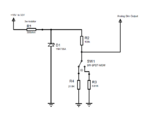Winsu
Full Member level 3
Hi All,
I have an application where the input voltage will be from 9V to 18V. I need to output a Voltage reference of 2.5V ( or around, between 6V and 2V ) and I'm not sure what means Min operating current( max Colum).
I'm thinking to use the TS4040 and I'm setting my resistance as 162.5K, with that a guarantee a 40uA at 9V, but when I raise the voltage to 18V the current goes to 95uA. It is above the Max minimum operating current. Am I putting in risk the TS4040?. What is the maximum current it could take?
I have an application where the input voltage will be from 9V to 18V. I need to output a Voltage reference of 2.5V ( or around, between 6V and 2V ) and I'm not sure what means Min operating current( max Colum).
I'm thinking to use the TS4040 and I'm setting my resistance as 162.5K, with that a guarantee a 40uA at 9V, but when I raise the voltage to 18V the current goes to 95uA. It is above the Max minimum operating current. Am I putting in risk the TS4040?. What is the maximum current it could take?
